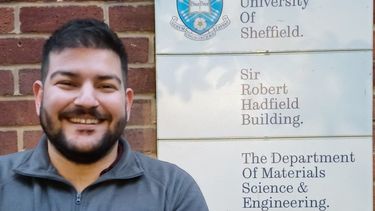The project initially entailed the design of a multiscale modelling approach to predict the elastic properties of any material. The application of this method, led to the discovery of an alloy with exceptional elastic properties but limited ductility. The focus of the project was then placed on improving the ductility to make it viable for use within the automotive industry. This led to the design of a novel alloy series exhibiting a balanced combination of elastic and mechanical properties, and unveiled potentially groundbreaking phenomena in the field along the way.
The reduction of greenhouse gas emissions (GGE) is one of the more prominent challenges of the automotive industry. The utilisation of lightweight automotive components without compromising their structural integrity can help achieve that. High Entropy alloys (HEAs) have the potential to address this challenge owing to their chemical flexibility, as they contain multiple principal alloying elements.
To tackle the difficulty in predicting the elastic properties of any HEA a novel computational methodology was designed, based on the combination of density functional theory (DFT), CALPHAD and Finite Element Modelling (FEM) alongside experimental verification. During the testing phase of this method, multiple alloys were evaluated, one of them being the equiatomic AlTiVCr alloy. This was found to possess elastic properties far surpassing those of even the more advanced high modulus steels, but exhibited extensive cracking during manufacturing. It was originally thought this derived from an order-disorder transformation taking place, where atoms shift from a random arrangement to a more structured pattern, negatively impacting ductility. Interestingly, while heat treatments managed to partially inhibit the transformation, no improvements in ductility were observed. As such, compositional modifications ensued, aimed at fully suppressing the transformation. While this was achieved by reducing the aluminium (Al) content of the alloys, it also led to a significant drop in their elastic properties, which is a counter-intuitive finding given that Al has one of the lowest elastic properties amongst metals. It was revealed that the Al addition may be modifying the bonding type of the alloys from metallic to partially covalent, leading to the manifestation of these impressive properties.
These findings lay the foundations for manipulating the elastic properties of Al-containing HEAs, while the associated methodologies guided the discovery of candidate alloys for lightweight high stiffness applications.
In truth, none of this would've been possible without an amazing team. I truly feel honoured to have worked alongside such amazing researchers at the University of Sheffield and Volkswagen. Their trust in me and my abilities, the freedom they allowed me when designing and steering the project, and their continuous support is what made this work a reality. Five years ago I made the decision to leave my home in Greece and begin my PhD at the UK to pursue true innovation and to do "good science", and "good science" we did. Thank you.
Paul Stavroulakis
IMPACT
This work highlighted a mechanism which had never before been encountered in conventional metallic materials.
One of the more common cases of modifying the elastic properties of alloys would be encountered in the field of Titanium alloys for biomedical applications. There, the addition of certain alloying elements could induce phase transformations leading to the manifestation of reduced elastic properties which is a desirable effect in Biomedical Engineering. On the contrary, increasing the elastic properties of alloys was thought to be predominantly if not entirely dependent on the elastic properties of their constituent alloying elements.
The bond altering mechanism demonstrated in this study was, to the authors knowledge, never before encountered in a metallic material to the same extent. To put some numbers into this, imagine that minor modifications to the chemical composition could lead to a change of over 46% in terms of the specific elastic properties! This was achieved without inducing any phase transformations or the formation of secondary phase particles. And this is only scratching the surface of the findings encapsulated within this work which aided the discovery of two alloys exhibiting notable potential for application within the automotive industry.
While the field of HEAs is still in its infancy, this project demonstrated the feasibility of an ICME methodology for navigating their vast compositional space, also demonstrating the vast flexibility this novel alloy grade can offer. From reducing greenhouse gas emissions by designing more sustainable materials exhibiting interesting properties, to pushing the boundaries of our understanding of materials science, with potential to revolutionise the alloy design of tomorrow!
BIO
Paul Stavroulakis graduated from the National Technical University of Athens, Greece in 2018 with a Master of Engineering in Mining and Metallurgical Engineering, specialising in Materials Science and Engineering. He completed his PhD in 2023 at the University of Sheffield as a member of the Advanced Metallic Systems CDT. His project, Development of Lightweight High Stiffness Alloys assisted by Integrated Computational Materials Engineering, was sponsored by Volkswagen AG.
During his time as a Postgraduate Researcher at the University of Sheffield, Paul supervised and designed multiple diploma theses, was involved in several research and consultancy projects, and facilitated collaborations at a national and international level. He also undertook a 3-month placement at Volkswagen in Wolfsburg, Germany, as part of Group Innovation in 2022. In 2023, Paul worked at the Hellenic Research Centre for Metals S.A. as a Metallurgical Engineer. He is currently carrying out his 9-month Military Service at the Hellenic Navy as a Quality Control Engineer, and is stationed at the Naval Base of Salamis, Greece.
EQUIPMENT
Arcast 200 Arc 200 - Royce Discovery Centre
MicroMaterials Nanotest Vantage - Royce Discovery Centre
X'Pert3 Powder with the Anton Paar HTK12N furnace attachment - Royce Discovery Centre
Inspect F50 - Sorby Centre
ThermoFisher Talos F200 - The University of Manchester
ThermoFisher Scientific Scios 2 DualBeam - Volkswagen AG
Instron 68FM-100 - Volkswagen AG
Hot Disk TPS 2500S - Volkswagen AG
ARCHER/ARCHER2 UK National Supercomputing Service


